Need to unwind and reconnect with nature? You'll find solace in these peaceful walks: immerse yourself in Japanese-inspired forest bathing, stroll along misty coastal cliffs, or experience dawn's tranquility by a lake. Wander through mountain meadows dotted with wildflowers, explore curated botanical gardens, or find serenity on desert canyon paths. You can discover wetland wonders via boardwalks, practice mindful walking in pine forests, or meander through wildflower valleys. Each path offers unique therapeutic benefits, from immune-boosting forest air to the calming rhythm of ocean waves. Let's explore these natural sanctuaries that await your footsteps.
Forest Bathing in Ancient Woods
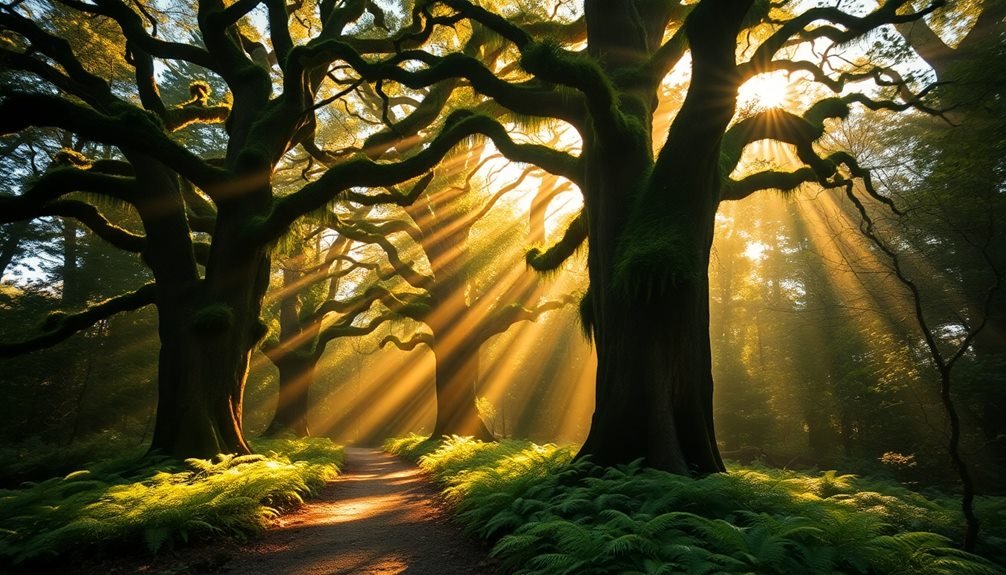
While the concept originated in Japan as "shinrin-yoku," forest bathing has become a powerful therapeutic practice worldwide.
You'll discover it's more than just walking through trees – it's a mindful immersion in nature that engages all your senses. As you step into ancient woodlands, you're surrounded by phytoncides, natural compounds released by trees that boost your immune system and reduce stress hormones.
Start by finding a quiet forest trail where old-growth trees create a natural canopy. You'll want to move slowly, paying attention to the soft crunch of leaves beneath your feet and the filtered sunlight dancing through branches.
Breathe deeply, letting the forest air fill your lungs. Notice how the moss feels against your fingertips and listen to the gentle rustle of wind through the leaves.
For maximum benefit, spend at least two hours in the forest. You can sit quietly on a fallen log, meander along worn paths, or find a clearing to practice gentle stretches.
The key is to remain present and let the ancient woodland's rhythms sync with your own natural pace.
Coastal Cliff Path Strolls
Trading the sheltered forest for open skies, coastal cliff paths offer a different kind of natural therapy. As you walk along these windswept trails, you'll experience the raw energy of waves crashing against rocks below, while seabirds glide overhead on thermal currents. The combination of negative ions from the sea spray and the rhythmic sound of breaking waves creates a naturally calming environment.
You'll find that coastal paths challenge you differently than forest walks. The terrain varies from gentle grass-covered slopes to rocky outcrops, requiring mindful stepping and engaging your core muscles. The exposure to wind and weather keeps you present and focused, while vast ocean views expand your perspective and help put daily worries into context.
For the best experience, time your walk for early morning or late afternoon when the light is softer and crowds are thinner. Bring layers of clothing to adjust to changing conditions, and don't forget to pause at viewpoints to observe passing ships, diving gannets, or breaching dolphins.
These moments of stillness amid nature's grandeur can provide profound mental clarity and emotional release.
Lakeside Dawn Meditation Walk
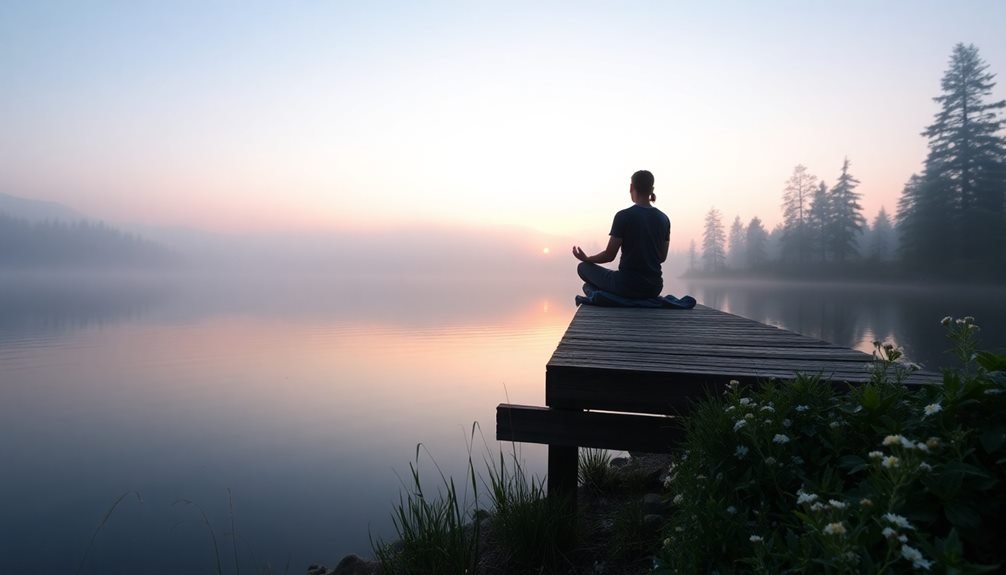
As you walk along the lake's edge at dawn, you'll find yourself enveloped in a mystical morning mist that transforms the familiar landscape into something extraordinary.
The gentle ripples of water create a natural rhythm that syncs with your breathing, making this the perfect time for moving meditation.
You'll feel the lake's energy flow through you as you mindfully pace the shoreline, where water meets land in a sacred morning dance.
Morning Mist Experience
The soft veil of morning mist creates an ethereal atmosphere perfect for meditation by the lake. As you step onto the moistened path, you'll notice how the fog transforms familiar landscapes into mysterious, dream-like scenes. The mist dampens sounds, creating a natural silence that helps you focus on your breathing and presence.
During these early hours, you'll experience the gradual revelation of nature as sunlight pierces through the fog. Watch as dewdrops on spider webs glisten like strings of pearls, and listen for the gentle rustling of awakening wildlife. The cool, moisture-laden air refreshes your lungs with each breath, while the limited visibility encourages you to rely more on your other senses.
Position yourself near the water's edge, where the mist appears to dance across the lake's surface. You'll witness the interplay between water and air as tendrils of fog rise and dissipate. This is an ideal moment to practice mindfulness – observe how the mist mirrors your thoughts, appearing substantial yet passing naturally.
As the morning progresses, you'll see the mist slowly lift, revealing the lake's true expanse.
Connect With Water Energy
Gentle waves lapping against the shoreline draw you into a deeper state of serenity during your lakeside dawn meditation walk.
The rhythmic motion of water creates a natural meditation soundtrack, helping you sync your breath with each wave's ebb and flow.
Find a comfortable spot near the water's edge where you can sit safely on a flat rock or bring a portable chair.
Let your bare feet dangle just above the water's surface, allowing the cool moisture to heighten your sensory awareness.
As you settle in, notice how the lake's surface mirrors the sky's changing colors, from deep purple to soft pink and finally brilliant gold.
Focus on the water's perpetual movement – it's never truly still, yet maintains perfect balance.
You'll feel this same equilibrium settling into your body as you breathe deeply.
Watch how water birds glide effortlessly across the surface, creating gentle ripples that expand outward.
They're showing you how small actions create far-reaching effects.
Before leaving, cup some water in your hands and feel its life-giving energy.
You're now carrying this peaceful water energy within you for the rest of your day.
Mountain Meadow Wandering
Mountain meadows' vibrant wildflowers and swaying grasses create nature's most peaceful sanctuary for wandering minds. As you step into these high-altitude havens, you'll find yourself surrounded by a tapestry of colors, from purple lupines to golden buttercups. The gentle mountain breeze carries the sweet scent of alpine flowers, inviting you to pause and breathe deeply.
You'll discover that mountain meadows offer unique opportunities for mindful exploration. Walk slowly along natural paths carved by wildlife, letting your fingers brush against tall grass stems. Stop occasionally to observe butterflies dancing from bloom to bloom or listen to the gentle humming of bees.
These meadows often provide clear views of distant peaks, allowing your eyes to rest on far horizons. For the best experience, visit during early morning or late afternoon when the slanting sunlight illuminates the meadow like nature's spotlight.
You'll find pocket-sized clearings perfect for sitting quietly, where you can watch cloud shadows race across the grassland. Remember to stay on established trails to protect delicate alpine vegetation, and you'll help preserve these serene spaces for future wanderers.
Botanical Garden Pathways
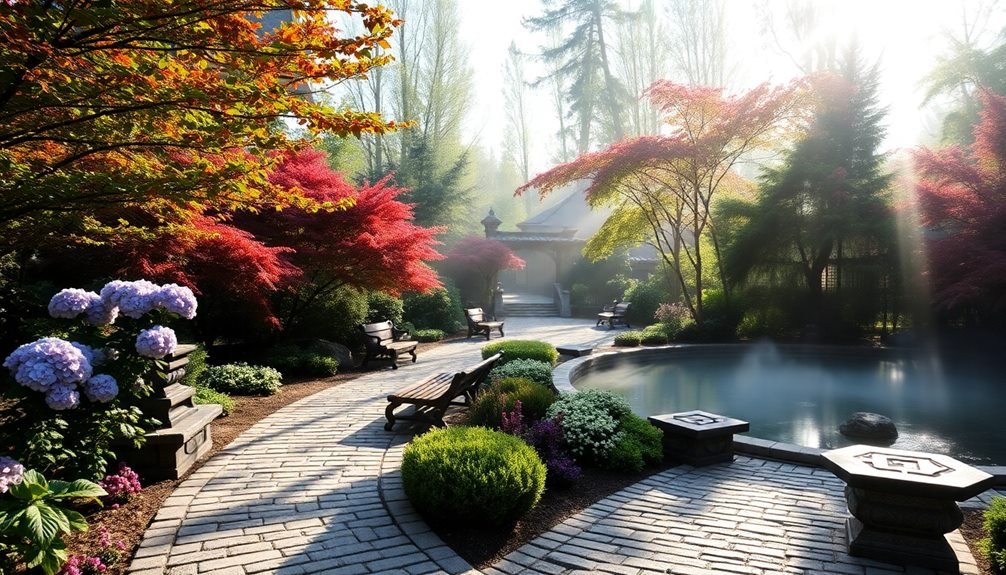
Botanical gardens offer you a curated journey through seasonal blooms, with thoughtfully arranged pathways that showcase nature's ever-changing colors and textures.
You'll discover layouts designed to highlight each season's unique beauty, from spring tulip displays to autumn chrysanthemum collections.
The garden's hidden benches and secluded alcoves invite you to pause and reflect, creating peaceful moments among the manicured landscapes.
Seasonal Blooms and Layouts
Stunning garden pathways wind through meticulously planned seasonal displays, offering visitors a changing canvas of colors and textures throughout the year.
You'll discover carefully curated sections that showcase nature's finest specimens, from early spring bulbs to late autumn foliage. The garden's layout guarantees you're never far from a seasonal highlight, with each turn revealing new botanical treasures.
As you explore these living galleries, you'll notice how the garden's design maximizes each season's unique offerings:
- Spring pathways guide you through beds of tulips, daffodils, and flowering cherries, creating a symphony of pastels and sweet fragrances
- Summer routes showcase vibrant perennial borders, rose gardens, and drought-resistant native plants in peak bloom
- Fall trails highlight autumn favorites like chrysanthemums, ornamental grasses, and trees with spectacular foliage
- Winter walks feature sculptural evergreens, bright berries, and winter-blooming plants like hellebores
- Shifting periods blend outgoing and incoming seasonal displays, guaranteeing continuous interest
You'll find helpful markers and maps throughout the gardens, identifying key specimens and suggesting ideal viewing routes for each season's distinctive display.
Hidden Benches and Alcoves
Throughout these winding paths, you'll discover intimate seating areas tucked away in unexpected corners of the garden. Weathered wooden benches rest beneath drooping willows, while stone alcoves offer shelter from both sun and occasional rain showers.
These hidden spots provide perfect meditation points where you can pause and reconnect with nature. You'll find these secluded nooks strategically placed near some of the garden's most enchanting features. Some benches face bubbling fountains or koi ponds, while others overlook vibrant flower beds or pristine rock gardens.
There's even a series of bamboo-screened alcoves that create natural privacy screens, perfect for journaling or quiet contemplation. Don't miss the elevated viewing points, where carefully positioned benches offer sweeping views of the entire garden landscape.
These spots are particularly magical during sunrise and sunset. For those seeking complete solitude, explore the moss-covered stone benches tucked into the shade garden, or find the curved wooden seats that blend seamlessly into the native plant section.
Each hidden spot offers its own unique perspective of the garden's natural beauty, allowing you to experience the grounds from different vantage points.
Riverside Walking Trails
Winding alongside crystal-clear waters, riverside walking trails offer you a perfect blend of scenic beauty and tranquility. You'll find these paths particularly soothing as the gentle sound of flowing water creates a natural meditation soundtrack.
The combination of water views and well-maintained pathways makes riverside trails ideal for both casual strolls and mindful walking exercises.
These riverside sanctuaries provide unique features that enhance your walking experience:
- Frequent resting spots where you can pause to watch the water's natural flow and observe local wildlife
- Natural cooling effects from the water, making these trails comfortable even on warmer days
- Diverse ecosystems that change with each season, offering new perspectives throughout the year
- Wide, stable paths that accommodate various walking speeds and abilities
- Natural sound barriers created by the water's flow, helping to block out urban noise
As you walk, you'll notice how the river's constant movement mirrors life's continuous flow.
These trails often connect to larger networks of paths, letting you customize your route's length and difficulty while maintaining that peaceful riverside ambiance.
Desert Canyon Serenity Routes

Desert canyons reveal nature's hidden sanctuaries along carefully carved hiking routes. You'll discover dramatic rock formations and surprising pockets of life as you navigate these serene pathways. The towering walls provide welcome shade, while the echo of your footsteps mingles with the gentle desert breeze.
When you're seeking tranquility, follow established trails like Cathedral Canyon or Silent Gorge, where you'll find peaceful alcoves perfect for meditation. These routes often feature morning shade, making them ideal for early walks before the heat intensifies. You'll want to bring plenty of water and wear appropriate sun protection, even in cooler months.
The desert canyon's unique acoustics create natural sound chambers where you can experience profound silence interrupted only by birdsong or the rustle of small wildlife.
You'll notice how the sunlight changes the canyon's colors throughout the day, from soft pinks at dawn to deep oranges at sunset. Look for hidden springs and seasonal waterfalls that create unexpected oases, attracting desert bighorns and various bird species.
These paths offer both physical exercise and mental restoration as you wind through nature's ancient corridors.
Wetland Boardwalk Explorations
You'll discover rich wildlife viewing opportunities that change with each season as you stroll along elevated wooden boardwalks winding through vibrant wetland ecosystems.
The accessible paths let you safely explore marshy areas while protecting delicate habitats, offering prime spots to observe migratory birds, turtles, and flowering vegetation.
Your nature photography will benefit from the stable platforms, where you can capture close-ups of native plants like cattails and water lilies during golden hour lighting.
Seasonal Wildlife Viewing Spots
Throughout the year, local wetland boardwalks offer prime opportunities to spot diverse wildlife in their natural habitat.
You'll find that each season brings unique viewing experiences, from spring migrations to winter roosting patterns. Position yourself at designated observation points during dawn or dusk when animals are most active.
For the best wildlife viewing experiences, remember these essential spots:
- Dawn viewing platforms near the marsh edges, where you'll catch sight of herons and egrets hunting for breakfast
- Sheltered bird blinds overlooking feeding areas, perfect for photographing waterfowl without disturbing them
- Elevated observation decks that provide clear views of turtles basking on logs during warmer months
- Protected coves where beavers and muskrats frequently appear during their evening activities
- Peninsula lookouts that give you prime views of migrating songbirds in spring and fall
Consider visiting the same spots throughout different seasons to observe how wildlife patterns change.
You'll notice that morning fog often creates magical conditions for viewing, while late afternoon light offers excellent photography opportunities.
Bring binoculars and a field guide to enhance your wildlife spotting experience.
Accessible Wooden Trail Routes
Along the wetland's edge, well-maintained wooden boardwalks provide stable, accessible paths for nature enthusiasts of all mobility levels.
You'll find these elevated walkways stretching across marshes, ponds, and low-lying areas, offering unique vantage points to observe wetland ecosystems without disturbing sensitive habitats.
The boardwalks feature non-slip surfaces, sturdy handrails, and periodic rest areas with benches. You can easily navigate these routes with wheelchairs, walkers, or strollers, as the paths maintain a consistent width of at least four feet.
Most sections include passing zones where you'll find informative placards describing local flora and fauna.
You'll discover several loop options ranging from quarter-mile circuits to more extensive one-mile routes.
These paths connect to key observation points where you're likely to spot waterfowl, turtles, and native plants.
During dawn and dusk, you'll have the best chances of witnessing active wildlife while enjoying the boardwalk's quiet atmosphere.
In winter months, the treated lumber surfaces receive regular maintenance to prevent ice formation, ensuring year-round accessibility for your nature exploration needs.
Native Plant Photography Tips
Wetland boardwalks consistently provide ideal platforms for photographing native plants, offering stable shooting positions and minimal camera shake.
You'll find that early morning or late afternoon light creates the most striking images, as the golden hours enhance the natural colors and textures of wetland flora.
When photographing native plants along boardwalks, you'll want to follow these essential tips to capture their beauty:
- Get down to eye level with your subject by carefully kneeling or sitting on the boardwalk, which helps create more intimate plant portraits.
- Use a macro lens or close-up filters to capture fine details like water droplets, pollen, or delicate flower structures.
- Frame your shots to include natural backdrops of water reflections or filtered sunlight through the surrounding vegetation.
- Consider using a polarizing filter to reduce glare from wet surfaces and enhance the richness of green foliage.
- Keep your ISO setting low and use a tripod whenever possible to maintain image sharpness in low-light conditions.
Remember to maintain a safe distance from sensitive species and stay on designated paths while pursuing your perfect shot.
You'll discover that wetland boardwalks offer unique vantage points for documenting local plant life throughout the seasons.
Pine Forest Walking Meditation
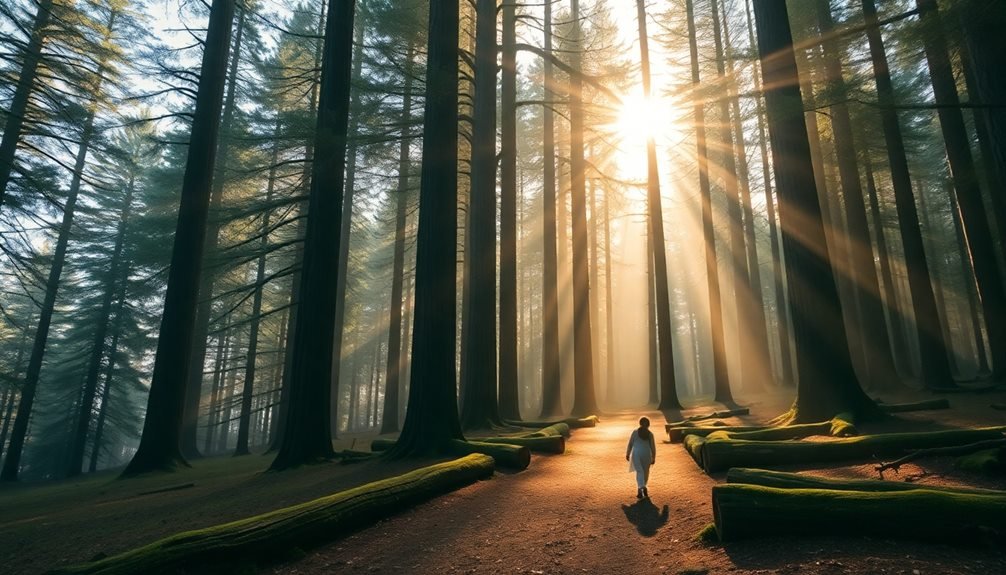
A pine forest's distinct aroma and soft needle-carpeted paths create the ideal setting for a walking meditation. As you enter the forest, pause to breathe in the crisp, resinous scent that pine needles release, especially after rain. This natural aromatherapy helps clear your mind and ground you in the present moment.
Begin your meditation by walking slowly, focusing on each deliberate step. You'll notice how the springy bed of pine needles cushions your feet, creating a natural sensory experience. Let your arms swing gently at your sides, and keep your gaze soft, about six feet ahead on the path.
As you walk, tune into the subtle sounds around you – the whisper of wind through pine boughs, the soft crunch of needles underfoot, and the occasional pine cone dropping nearby. If your mind wanders, don't fight it. Instead, gently return your focus to your breathing and footsteps.
For ideal benefits, maintain this mindful walking practice for at least 15 minutes. You'll find that pine forests offer unique advantages for meditation, as their canopy creates natural shelter and their uniform appearance reduces visual distractions.
Wildflower Valley Paths
Walking through and between vibrant wildflower meadows offers a different kind of mental refuge than forest paths. You'll find yourself surrounded by dancing colors and gentle movements as butterflies and bees navigate from bloom to bloom. The open sky above creates an expansive feeling that helps release mental tension and broadens your perspective.
As you walk these valley paths, you'll notice how the terrain shifts beneath your feet, from packed earth to softer ground carpeted with fallen petals. Your senses will naturally tune into the subtle changes in temperature as you move between sun-warmed spaces and cooler pockets of shade.
- Let your gaze soften and take in the entire landscape rather than focusing on individual flowers
- Match your breathing to your walking rhythm, taking deeper breaths when climbing gentle slopes
- Pause occasionally at natural viewpoints to observe the interplay of light and shadow
- Run your hands gently over tall grasses as you pass, engaging your sense of touch
- Listen for the distinct sounds of grasshoppers and crickets hidden among the blooms
Choose early morning or late afternoon walks when the light is gentler and the flowers are most fragrant.
Frequently Asked Questions
What Essential Safety Gear Should I Bring for Solo Nature Walks?
You'll need a first-aid kit, fully charged phone, whistle, water bottle, weather-appropriate clothing, and sturdy shoes. Don't forget to bring a map, compass, and flashlight for navigation and emergencies.
How Can I Identify and Avoid Poisonous Plants During My Walks?
You'll spot poisonous plants by learning their distinct features: three-leaf patterns, red stems, or waxy leaves. Stick to marked trails, wear long pants, and download a plant ID app for quick identification.
Are Tranquil Nature Walks Suitable for People With Mobility Limitations?
You can enjoy nature walks with mobility limitations by choosing paved trails, using mobility aids, and researching accessible paths beforehand. Many parks offer wheelchair-friendly routes and resting spots along the way.
What's the Best Time of Year for Wildlife Spotting During Walks?
You'll spot the most wildlife during spring and early summer when animals are active breeding and feeding. Dawn and dusk offer prime viewing times, while migrations bring diverse species in fall.
Should I Inform Someone About My Walking Route Before Departing?
Yes, you should always tell someone where you're going and when you'll return. Share your planned route and expected timeline – it's an essential safety measure if something unexpected happens during your walk.
In Summary
You'll find that these nature walks offer more than just exercise – they're gateways to inner peace and clarity. Whether you're forest bathing among ancient trees or wandering through desert canyons, each path provides a unique opportunity to reset and recharge. Take time to explore these tranquil routes, and you'll discover that nature's rhythm has a way of aligning perfectly with your own.

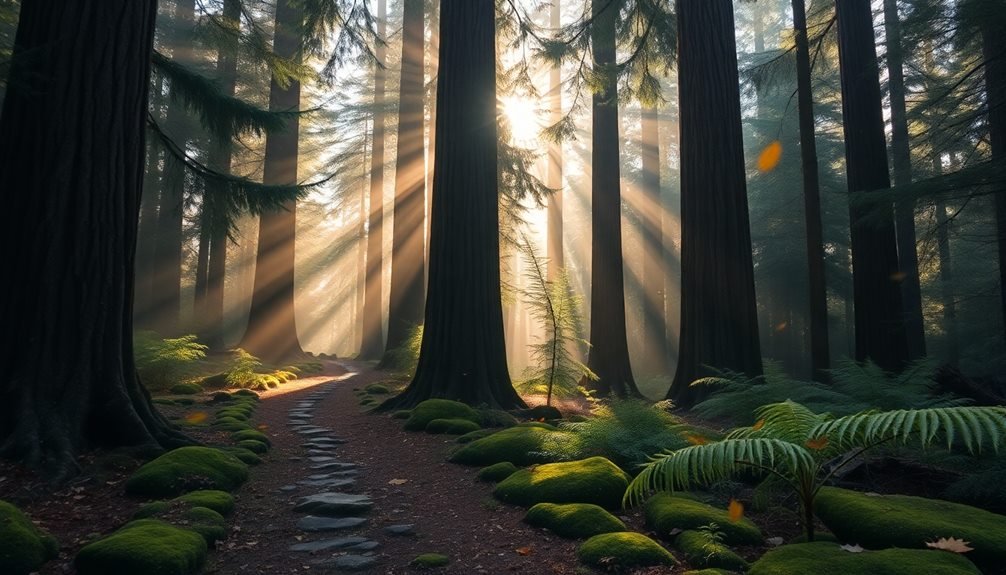



Leave a Reply